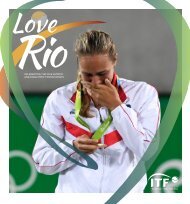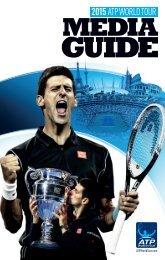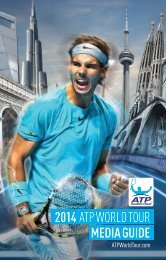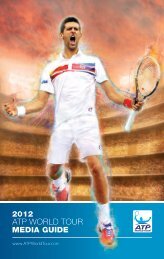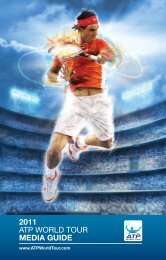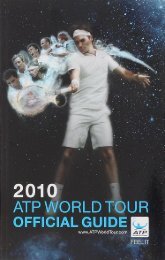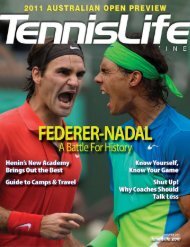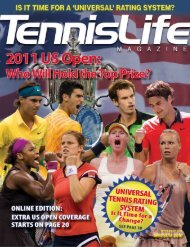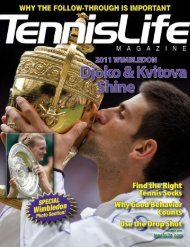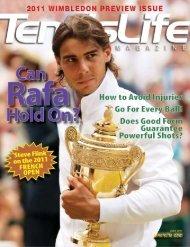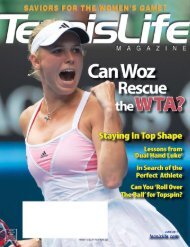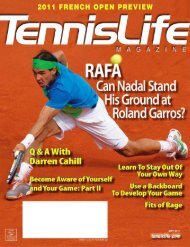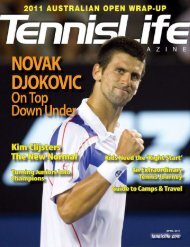A Champion's Mind - Pete Sampras
www.tennismoscow.me Insta:TENNISMOSCOW
www.tennismoscow.me Insta:TENNISMOSCOW
Create successful ePaper yourself
Turn your PDF publications into a flip-book with our unique Google optimized e-Paper software.
ait-and-switch move or not, but I agreed to meet with Tim.<br />
We met in Florida, hit some balls, and talked. Tim, it turned out, was more easygoing than Tom, which<br />
suited me. He was also gregarious—a natural communicator, which would be a good quality in the coach<br />
of a reticent, reserved kid like me. While never a great player himself, Tim was a student of greatness and<br />
loved being around it. By nature, Tim was an attacker with a superb volley, so he had an affinity for my<br />
style. And he was still a young man—just about forty when we met—so he had energy, passion, and<br />
commitment. I decided to hire him, effective January 1992.<br />
The unsettled coaching situation contributed to my inconsistency during the fall of ’91. I took a loss to<br />
Brad Gilbert in Sydney, but won Lyon. I had back-to-back losses to Boris Becker and Guy Forget in<br />
Stockholm and at the Paris Indoors. I put a little balm on my wounds at the year-end ATP Finals, where I<br />
beat Agassi in the round-robin and Lendl and Courier, back-to-back, to win the fifth most important<br />
tournament of the year.<br />
My last event of the year was my Davis Cup debut, against France, back in Lyon. Those who love Davis<br />
Cup, like John McEnroe or Andy Roddick, make it a top priority and consider it the ultimate honor.<br />
Playing with the name of your country on the back of your shirt and on the scoreboard is a unique<br />
experience. On that I’ll agree. It creates a special kind of pressure that you just don’t feel when you’re<br />
playing for yourself, even at places like Wimbledon or Flushing Meadows.<br />
Davis Cup is a team effort, which is also different and interesting, and the nationalistic nature of the<br />
competition ensures that you play under some conditions you just don’t have to face on the tour.<br />
Everything gets magnified or skewed in Davis Cup, and you can throw the records, the rankings, and the<br />
form chart out the window. That makes Davis Cup a tough assignment for a rookie.<br />
The Davis Cup format is a single-elimination tournament featuring sixteen nations that have qualified<br />
for the elite World Group, and each match (in Davis Cup it’s called a “tie”) consists of five matches—<br />
four singles and a doubles—that are played over three days (Friday through Sunday). The teams usually<br />
devote the entire week leading into the weekend tie to on-site practice, so Davis Cup can eat up as much<br />
as four weeks of a player or team’s time.<br />
The four Davis Cup weeks take place over the course of the year; the big final is played in late<br />
November or early December. The home-field advantage (every tie is either a home or an away match) is<br />
determined by previous history on a simple basis: the teams take turns hosting ties. So if the last time<br />
France played the United States the tie was played in France, the United States is automatically the host<br />
for the next meeting—even if it doesn’t happen for four or eight to twelve years. Hosting is a huge<br />
advantage. You get to fill the stadium with your home crowd (and Davis Cup fans are the rowdiest and<br />
most vocal in tennis), but even more important, you get to choose where you play (indoors or out, at a<br />
small club or in a huge arena) and on what surface.<br />
Davis Cup didn’t mean much to me when I was growing up. I don’t remember watching it on television<br />
(and it isn’t like Davis Cup was all over the tube back in the pre-cable days). So I had no pre-existing<br />
reverence for the event. This made it tough to commit to Davis Cup because, like most top players, I put<br />
the ability to perform at my peak in Grand Slams at the top of my priorities. And Davis Cup asked for a<br />
lot, timewise.<br />
In 1991, France put together a magical run under captain Yannick Noah, a very popular former player<br />
and French Open champion. Guy Forget and Henri Leconte, two flashy lefties, carried the French squad to<br />
its first final in the Open era. And the French also had the home-court advantage over their final-round<br />
rivals—the United States. They chose to play the tie on fast carpet in an indoor stadium in Lyon.<br />
When France announced the surface, U.S. captain Tom Gorman had a stroke of genius—at least<br />
theoretically. Although I had lost my U.S. Open title in the “ton of bricks” match, I was the best fast-court



